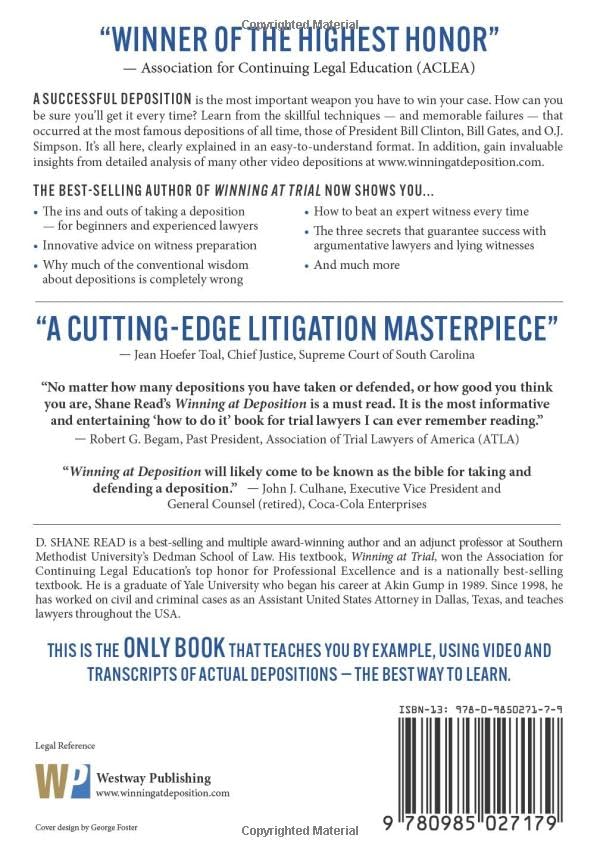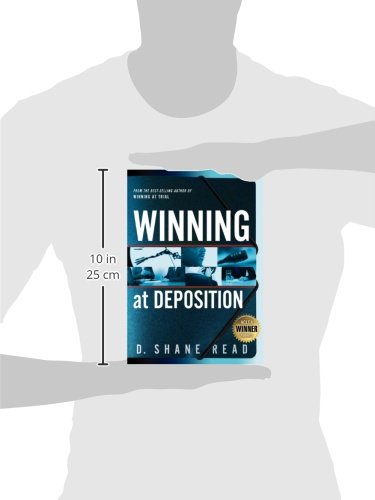



Winning at Deposition: (Winner of ACLEA's Highest Award for Professional Excellence)
B**
Excellent book!
Winning at Deposition lives up to the high expectations I had for it based on its winning the Professional Excellence Award from the Association of Continuing Legal Education (ACLEA), the reviews from Bar Journals, and the endorsements from presidents of national trial lawyers associations. I am an experienced litigator and found the textbook so helpful that I wanted to summarize the main points so other lawyers could decide if they should buy the book as a reference book. I am very glad that I did. This book has everything a new or experienced attorney needs. It covers all the essential topics and challenges the conventional wisdom throughout.There are so many things that set this book apart from the material in the Evidence book we had to read in law school and the other ones that I have read since then. First, the book is filled with practical tips that you can immediately use to improve your deposition skills. These tips are not lost in theoretical discussions as so often happens in other books. For example, throughout the book, there are call-out boxes to highlight the important strategy or tip that is being discussed. These call-out boxes reinforce the text.For example, one of the first call-out boxes reminds an experienced litigator—or teaches a new attorney—that “Less is more. If you take a short deposition that is focused and to the point, you not only save time but you will need less time to review it prior to trial when time is precious.” This profound lesson is one that I wish that I had learned earlier in my career and is a much needed teaching point that challenges the conventional wisdom where lawyers are taught to take as long a deposition as allowed, and ask as many questions as possible. By following the conventional wisdom instead of the author’s advice, lawyers wind up losing their focus during the deposition, going down needless rabbit holes, and then having a transcript that is extremely time-consuming to summarize and cumbersome to use for mediation, summary judgment, or trial.In addition to the call-out boxes, the book teaches its points through the mistakes trial lawyers have made and successes they have achieved in actual depositions. This teaching approach makes the lessons that are taught memorable. One lesson is the maxim that is a deposition is worth taking, it should be videotaped. Why? The author reinforces his teaching principle with an example from Bill Gates’ deposition where he gave a seemingly reasonable answer if you just looked at the transcript. But because the deposition was videoed, the lawyer taking the deposition, David Boies, is able to show that because Gates waited almost a minute to answer a straightforward question, his answer shows the witness’s evasiveness and uncomfortableness with the question.This model of teaching deposition skills through the use of actual and famous depositions shines even further in Chapter Eight when the author analyzes Bill Clinton’s deposition. The subject matter is fascinating and the teaching points are memorable because they are associated with one of the most famous depositions in legal history.In chapter 10, the reader is treated to analyses of video depositions that are hosted on the book’s website. Being able to see the good and bad techniques executed by different attorneys is a treasure trove of learning. In addition, the author points out the good and bad things that the witnesses do and how you could have prepared them to handle the questions better if you had been the attorney. These videos include Bill Gates’ deposition, one of the most famous trial lawyers of all time, an expert witness caught making assumptions that he should not have made, a mayor who repeatedly answers “I don’t know” to his detriment, and lawyers getting into a verbal fight and a near physical one. Like the author does with written transcripts throughout the book, the use of videos of actual depositions provides a wealth of teaching points that stick.Not only does the author use actual depositions (both transcripts and video) to make his points, he uses call-out boxes (as mentioned above) and chapter checklists to summarize each chapter. These checklists are very well thought out and not just summaries. Because of this, they are a wonderful reference tool for a lawyer who needs information in a hurry. For example, in the very helpful chapter on The Expert Witness, the chapter checklist highlights the important information in the chapter such as the criteria a witness must meet in order to testify as an expert at trial (known as Daubert), who pays for the expert’s time at a deposition, the key things you need to do to prepare for an expert’s deposition, your style of questioning, “the keys to attacking an expert,” and “two areas not worth exploring at trial.” The author has such a helpful checklist for each chapter.In addition to the chapter checklists, there is a very thorough table of contents. For example, the table of contents breaks down the book into approximately three-page sections that reference the very useful section headings. For instance, in chapter two, Taking the Deposition, the table of contents replicates the 35 section headings for the chapter which allows you to quickly find exactly what you need to learn for the first time or refresh your memory in a hurry. This is combined with a well-organized index that allows you to quickly find specific answers on every topic covered in the book.Although all the chapters are chockful of easily digestible strategies and techniques, my favorite chapter is the one on Problems at a Deposition. It is one thing to describe them, but the author provides invaluable solutions that are easy to remember and implement. Every lawyer fears the deposition where the witness or the opposing attorney gets out of control and you are unable to get the information you are entitled to from the witness. How can you anticipate these problems, protect yourself from them, and then what steps can you take to resolve them if they happen?The author addresses every situation and clearly explains how to resolve the problem. I don’t want to list all of them here, but the twenty topics covered include what to do when: (1) a witness gives an implausible answer, (2) a witness hedges his bets, (3) a witness pretends not to understand a question, (4) a witness pretends to forget, (5) the witness guesses, (6) the opposing attorney instructs a witness not to answer a question, (7) the opposing attorney makes improper objections, (8) the opposing attorney improperly confers with his witness, (9) the opposing attorney objections too much, and (10) the opposing attorney personally attacks you.In summary, new and experienced attorneys will benefit immensely from the clear writing, depth of discussion of important topics, insights into taking and defending depositions in a much more productive way, and inspiration that the author gives throughout. I have written a lengthy review because I am a firm believer in the strategies discussed in this book and that you will really benefit from reading the book. Enjoy!
M**S
Every Litigator Needs This
Shane Read's book, Winning at Deposition, is concise, readable, and loaded with strategic insights and practical information. This book should be on every litigator's shelf.
B**Y
Simple Tools for Deposition
A great book for a deposition novice, looking for the basics, or a grizzled pro, seeking a reminder and distillation of the art. Highly recommend.
L**T
Highly Recommend
I wish someone had told me about this book when I first started practicing law! The tips in this book have been invaluable to my approach to a deposition. I even used his suggestion for how to prepare my “questions” for deposition in a hearing this week and found it not only easier to prepare, but it helped insure I covered all of the areas I wanted to cover. Do yourself a favor and get this book. I am starting Winning at Cross-Examination next, then his Winning at Trial.
A**I
Practical and useful
Not really a manual in any way just helpful tips
L**A
Win at Your First Deposition!
This book is extremely helpful for several reasons:(1) BREADTH: It covers the major topics one would need to review when taking or defending a deposition such as:Taking the deposition, defending the deposition, the expert witness, preparing your client for the deposition, problems at depositions (including a section on "dealing with difficult counsel at a deposition") and using the deposition at trial.(2) PRACTICE TIPS: Throughout the chapters there are quick "practice tips" and short summaries set off in little gray boxes. This helps orient the reader to what is being discussed and also helps the reader remember the content. Example: In the chapter discussing what questions are appropriate at a deposition, the book introduces the mnemonic CLIPS which stands for: Credibility, Lack of Knowledge, Implausible Statements, Prior Inconsistent Statements, and Support your Case.(3) SUMMARIES: At the end of each chapter there is a 1-2 page checklist summarizing the key points. You can just copy those pages and slip them into your deposition binder as a "cheat sheet" in case you forget what to do. Example: Suppose your witness is evading the question. This books give you ideas how to deal with that problem. Instead of getting flustered you check your cheat sheet and take control of the deposition.(4) EXAMPLES FROM REAL DEPOSITIONS: Throughout the chapters there are examples taken from real depositions to help demonstrate the points being discussed.In sum, I found this treatise extremely valuable and I highly recommend it to other lawyers. It will put you ahead of the game.
M**.
Dripping with practicality / No Filler
Pragmatic from the start. Featuring lists, acronyms, and excellent (succinct) case studies - this is a tremendous practical guide. Every new –or- experienced litigation attorney should read this book. I particularly enjoyed the sections on common witness problems: pinning down slippery witnesses at their depositions, and impeaching a forgetful/ recalcitrant witness at trial when their testimony changes from deposition.Mr. Read also offers some practical empowerment-- (1) the trial attorney needs a short summary for trial of the 3 truly critical areas of testimony (potential impeachment); a lengthy, elaborate regurgitation of the whole deposition won't be material to the jury and so it shouldn't be material to the advocate's preparation of every sub point. (2) Shortening for better clarity the list of steps needed for impeachment of a witness's later changed recollection -- the author pairs it down to the critical "ABC" steps.There is not a single chapter / page of filler in the book. The experienced advocate may be able to read a couple of the opening chapters more quickly. Even so this is a helpful library reference that I have already flipped back through in my first year of ownership. Highly recommended.
Trustpilot
1 week ago
3 weeks ago